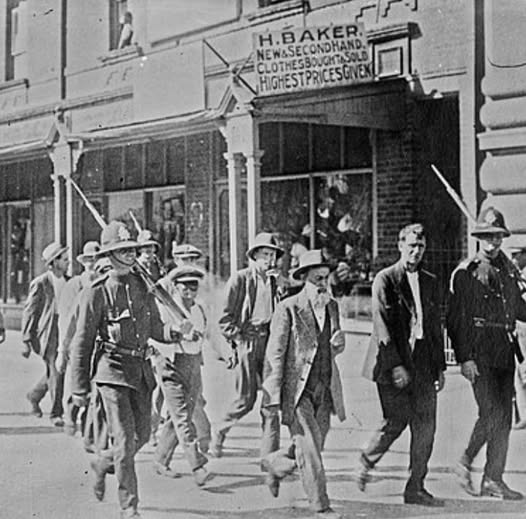Home › Forums › NATS NIBBLES › Rebel mine workers being taken prisoner in Fordsburg.-TRIP DOWN MEMORY LANE
- This topic is empty.
Viewing 1 post (of 1 total)
-
AuthorPosts
-
2025-01-05 at 20:47 #459111
 Nat QuinnKeymaster
Nat QuinnKeymasterRebel mine workers being taken prisoner in Fordsburg.
The Rand Rebellion (Afrikaans: Rand-rebellie; also known as the 1922 strike) was an armed uprising of white miners in the Witwatersrand region of South Africa, in March 1922. Jimmy Green, a prominent politician in the Labour Party, was one of the leaders of the strike.
Following a drop in the world price of gold from 130 shillings (£6 10s) per fine troy ounce in 1919 to 95s/oz (£4 15s) in December 1921, the companies tried to cut their operating costs by decreasing wages, and by weakening the colour bar by promoting cheaper black and Chinese mine workers to skilled and supervisory positions.
The rebellion started as a strike by white mine workers on 28 December 1921 and shortly thereafter, it became an open rebellion against the state. Subsequently the workers, who had armed themselves, took over the cities of Benoni and Brakpan, and the Johannesburg suburbs of Fordsburg and Jeppe.
The young Communist Party of South Africa (CPSA) took an active part in the uprising on grounds of class struggle whilst reportedly opposing racist aspects of the strike] as did the syndicalists.
Prime Minister Jan Smuts crushed the rebellion with 20,000 troops, artillery, tanks, and bomber aircraft. By this time the rebels had dug trenches across Fordsburg Square and the air force tried to bomb but missed and hit a local church. However, the army’s bombardment finally overcame them. Lieutenant Colonel Llewellyn Andersson’s role in creating the Union Defence Force was instrumental in crushing the rebellion.
Smuts’ actions caused a political backlash, and in the 1924 elections his South African Party lost to a coalition of the National Party and Labour Party. They introduced the Industrial Conciliation Act 1924, Wage Act 1925 and Mines and Works Amendment Act 1926, which recognised white trade unions. Under instruction from the Comintern, the CPSA reversed its attitude toward the white working class and adopted a new ‘Native Republic’ policy.
After the strike, 18 strikers were sentenced to death for murder, of which 14 were reprieved. The four men to not be reprieved, were Carel Christian Stassen, Taffy Long, Herbert Hull, and David Lewis, were all executed by hanging at Pretoria Central Prison. Stassen was hanged on October 5, 1922, while the other three men were hanged together on November 17, 1922. He was convicted of killing a black man, John Setsuta and a white miner John McKenzie. Long was convicted of killing a police informant, while Hull and Lewis were convicted of killing a soldier. As they marched to the gallows, Long began singing the “Red Flag”, the anthem of early white socialists in South Africa. He was joined in the song by the other two men. As they walked, all the prisoners sang with them.”

-
AuthorPosts
Viewing 1 post (of 1 total)
- You must be logged in to reply to this topic.
